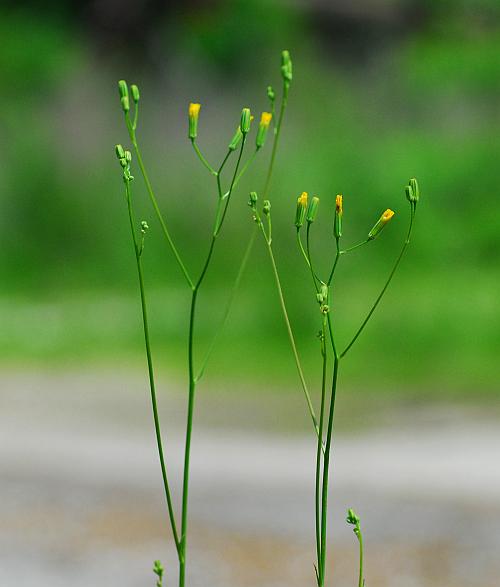Crepis pulchra L.
Small-Flowered Hawksbeard

Introduced
CC = *
CW = 5
MOC = 5
© SRTurner
Crepis pulchra L.Small-Flowered Hawksbeard | |
 |
Introduced CC = * CW = 5 MOC = 5 |
© SRTurner |
|
Family - Asteraceae/Cichorieae Habit - Taprooted annual forb with milky sap. Stems - Ascending to erect, to 1 m, unbranched below the inflorescence, sticky and moderately pubescent with glandular hairs.
Leaves - Basal and alternate. Basal leaves to 20 cm, petiolate, lobed or coarsely toothed, moderately pubescent with glandular hairs. Stem leaves similar, reduced toward tip, usually sessile and often with clasping triangular auricles.
Inflorescences - Loose terminal panicles.
Involucre - Cylindrical, the bracts in 2 series, the inner bracts 10-14, to 12 mm, similar in size, mostly lanceolate, the tip ascending at flowering, keeled, glabrous; the outer bracts much shorter.
Heads - Ligulate, receptacle glabrous. Ligulate florets 15-30, the corolla 5-12 mm long. Pappus of bristles 4-5 mm long.
Fruits - Dimorphic, the inner ones 4-5 mm long, the outer ones 5-6 mm long, more or less cylindrical, not beaked, 10-ribbed, the inner fruits with the ribs usually smooth, the outer fruits with the ribs usually minutely roughened or barbed, yellowish brown to light brown.
Flowering - May - July. Habitat - Open, disturbed areas. Origin - Native to Eurasia. Lookalikes - Other species of Crepis; more broadly, numerous plants in the Cichoreae tribe of the Asteraceae, particularly those in the genera Hieracium, Sonchus, Leontodon, Hypochaeris, and others. Other info. - This species is uncommon and sporadic in Missouri, currently reported from only a few counties. The genus is broadly recognized by open, wiry inflorescences and sessile, clasping stem leaves. Identification to species relies on a suite of characters requiring close examination. C. pulchra is a little easier than most, having stems which are sticky toward the base with glandular hairs. This commonly gives the lower stems a "dirty" appearance due to adherence of bits of foreign matter. Photographs taken at Weldon Spring Conservation Area, St. Charles County, MO, 5-9-2012, and along the Katy Trail near Dutzow, Warren County, MO, 5-29-2013 and 6-6-2020 (SRTurner). |